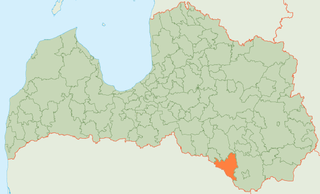
Latvia, officially the Republic of Latvia, is a country in the Baltic region of Northern Europe. It is one of the three Baltic states, along with Estonia to the north and Lithuania to the south. It borders Russia to the east and Belarus to the southeast, and shares a maritime border with Sweden to the west. Latvia covers an area of 64,589 km2 (24,938 sq mi), with a population of 1.9 million. The country has a temperate seasonal climate. Its capital and largest city is Riga. Latvians, who are the titular nation and comprise 63.0% of the country's population, belong to the ethnolinguistic group of the Balts and speak Latvian. Russians are the most prominent minority in the country, at almost a quarter of the population; 37.7% of the population speak Russian as their native tongue.

As of 1 May 2024, Latvia had a total population of 1,862,700. Demographic features of the population of the historical territory of Latvia include population density, ethnic background, education level, health of the populace, economic status, religious affiliations and other aspects of the population.

Riga is the capital, the primate, and the largest city of Latvia. Home to 605,273 inhabitants, the city accounts for a third of Latvia's total population. The population of Riga metropolitan area, which stretches beyond the city limits, is estimated at 860,142. The city lies on the Gulf of Riga at the mouth of the Daugava river where it meets the Baltic Sea. Riga's territory covers 307.17 km2 (118.60 sq mi) and lies 1–10 m (3–33 ft) above sea level on a flat and sandy plain.

Jūrmala is a state city in Latvia, about 25 kilometres west of Riga. Jūrmala is a resort town stretching 32 km and is sandwiched between the Gulf of Riga and the Lielupe River. It has a 33 km stretch of white-sand beach and is the fifth-largest city in Latvia.

Daugavpils is a state city in southeastern Latvia, located on the banks of the Daugava River, from which the city derives its name. The parts of the city to the north of the river belong to the historical Latvian region of Latgale, and those to the south lie in Selonia. It is the second-largest city in the country after the capital Riga, which is located some 230 kilometres northwest and is the ninth most populous city in the Baltic states.

Incorporation is the formation of a new corporation. The corporation may be a business, a nonprofit organization, sports club, or a local government of a new city or town.
A raion is a type of administrative unit of several post-Soviet states. The term is used for both a type of subnational entity and a division of a city. The word is from the French rayon, and is commonly translated as 'district' in English.

.lv is the Internet country code top-level domain (ccTLD) for Latvia. It was introduced on 29 April 1993, two years after the country's independence.

The Vends were a Balto-Finnic people that lived between the 12th to 16th centuries in the area around the town of Wenden in present-day north-central Latvia.

Ilūkste Municipality was a municipality in Selonia, Latvia. The municipality was formed in 2003 by merging Pilskalne Parish, Šēdere Parish, Bebrene Parish and Ilūkste town. In 2009 it absorbed Dviete parish, Eglaine parish and Subate town with its rural area the administrative centre being Ilūkste. In 2010 the rural area of Subate was reorganised as a separate territorial entity, Prode Parish. The population in 2020 was 6,412.

Ance Parish is an administrative territorial entity of the Ventspils Municipality, Latvia. The parish has a population of 712 and covers an area of 397.78 km2.
Unity is a liberal-conservative political party in Latvia. It is a member of the New Unity alliance and is positioned on the centre-right on the political spectrum. Since 2017, its chairman of the Main Board has been the former Minister for Economics of Latvia, Arvils Ašeradens, who succeeded former European Commissioner Andris Piebalgs.
The administrative divisions of Riga consists of six administrative entities: Central District, Kurzeme District, Latgale Suburb, Northern District, Vidzeme Suburb and Zemgale Suburb. Three entities were established 1 September 1941, and another three were established in October 1969. There are no official lower level administrative units, but the Riga City Council Development Agency is working on a plan, which when officially confirmed, will mean that Riga will consist of 58 neighbourhoods. The current names were confirmed 28 December 1990.

Mārupe is a town in, and the administrative centre of, Mārupe Municipality, Latvia. The town is a suburb of the Latvian capital, Riga, but is a separate entity. Mārupe borders Zemgale Suburb of Riga to its east and northeast. The headquarters of the Latvian Bandy Federation is located in Mārupe. A small river Mārupīte flows through the town.

The Ministry of Foreign Affairs is responsible for maintaining the Republic of Latvia's external relations and the management of its international diplomatic missions. The current Minister of Foreign Affairs is Baiba Braže.

The 2020 Riga City Council election was held from 26 to 29 August 2020 to elect the 60 members of Riga City Council. The election was initially scheduled for 25 April 2020, and then rescheduled three times – once due to a court ruling and twice due to the COVID-19 pandemic in Latvia, to 2 May, 6 June, and 29 August. The council will be elected for nearly five years instead of the standard four, and the next election is scheduled to take place in 2025, at the same time as all other municipal elections in Latvia.






















